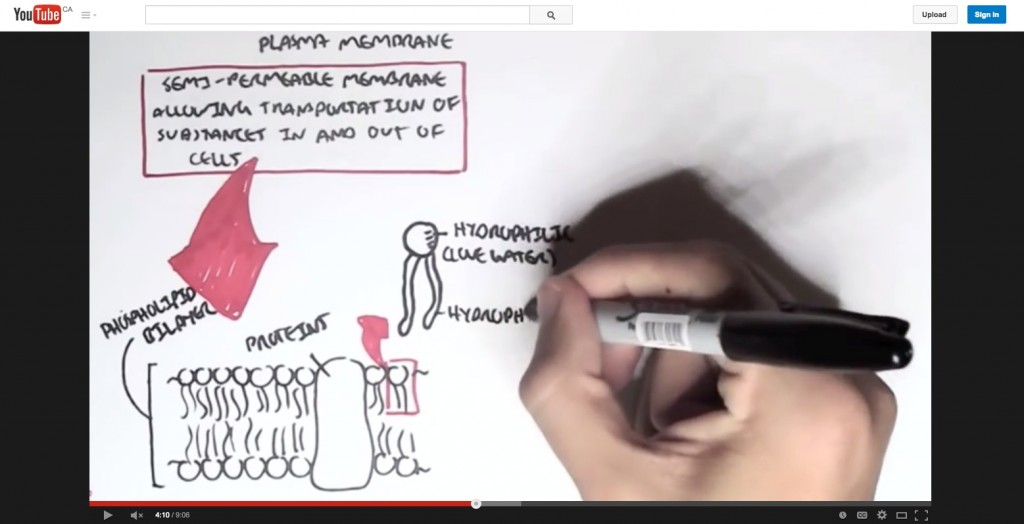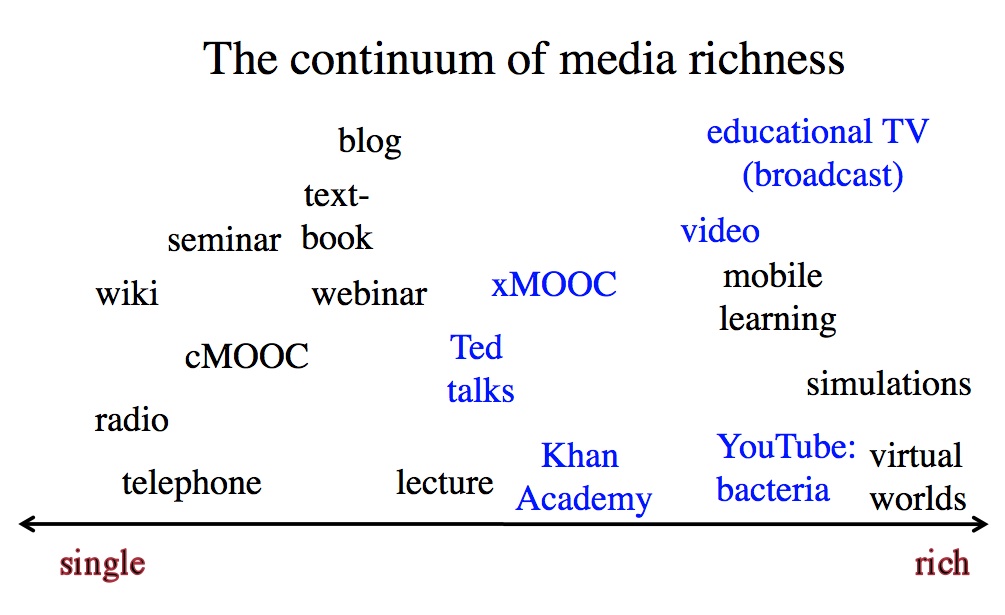6.6 Media richness
![]()

6.6.1 The historical development of media richness
In Section 6.2, ‘A short history of educational technology‘, the development of different media in education was outlined, beginning with oral teaching and learning, moving on to written or textual communication, then to video, and finally computing. Each of these means of communication has usually been accompanied by an increase in the richness of the medium, in terms of how many senses and interpretative abilities are needed to process information. Another way of defining the richness of media is by the symbol systems employed to communicate through the medium. Thus textual material from an early stage incorporated graphics and drawings as well as words. Television or video incorporates audio as well as still and moving images. Computing now can incorporate text, audio, video, animations, simulations, computing, and networking, all through the Internet.
6.6.2 The continuum of media richness
![]()

Once again then there is a continuum in terms of media richness, as illustrated in Figure 6.6.2 above. Also once again, design of a particular medium can influence where on the continuum it would be placed. For instance in Figure 6.6.2, different forms of teaching using video are represented in blue. Ted Talks are usually mainly talking heads, a televised lecture, as are often xMOOCs (but not all). The Khan Academy uses dynamic graphics as well as voice over commentary, and Armando Hasudungan’s You Tube video on the structure of bacteria uses hand drawings as well as voice over commentary. Educational TV broadcasts are likely to use an even wider range of video techniques.
However, although the richness of video can be increased or decreased by the way it is used, video is always going to be richer in media terms than radio or textbooks. Radio is never going to be a rich medium in terms of its symbols systems, and even talking head video is richer symbolically than radio. Again, there is no normative or evaluative judgment here. Radio can be ‘rich’ in the sense of fully exploiting the characteristics or symbol systems of the medium. A well produced radio program is more likely to be educationally effective than a badly produced video. But in terms of representation of knowledge, the possibilities of radio in terms of media richness will always be less than the possibilities of video.
6.6.3 The educational value of media richness
But how rich should media be for teaching and learning? From a teaching perspective, rich media have advantages over a single medium of communication, because rich media enable the teacher to do more. For example, many activities that previously required learners to be present at a particular time and place to observe processes or procedures such as demonstrating mathematical reasoning, experiments, medical procedures, or stripping a carburetor, can now be recorded and made available to learners to view at any time. Sometimes, phenomena that are too expensive or too difficult to show in a classroom can be shown through animation, simulations, video recordings or virtual reality.
Furthermore, each learner can get the same view as all the other learners, and can view the process many times until they have mastery. Good preparation before recording can ensure that the processes are demonstrated correctly and clearly. The combination of voice over video enables learning through multiple senses. Even simple combinations, such as the use of audio over a sequence of still frames in a text, have been found more effective than learning through a single medium of communication (see for instance, Durbridge, 1984). The Khan Academy videos have exploited very effectively the power of audio combined with dynamic graphics. Computing adds another element of richness, in the ability to network learners or to respond to learner input.
From a learner’s perspective, though, some caution is needed with rich media. Two particularly important concepts are cognitive overload and Vygotsky’s Zone of Proximal Development. Cognitive overload results when students are presented with too much information at too complex a level or too quickly for them to properly absorb it (Sweller, 1988). Vygotsky’s Zone of Proximal Development or ZPD is the difference between what a learner can do without help and what can be done with help. Rich media may contain a great deal of information compressed into a very short time period and its value will depend to a large extent on the learner’s level of preparation for interpreting it.
For instance, a documentary video may be valuable for demonstrating the complexity of human behaviour or complex industrial systems, but learners may need either preparation in terms of what to look for, or to identify concepts or principles that may be illustrated within the documentary. On the other hand, interpretation of rich media is a skill that can be explicitly taught through demonstration and examples (Bates and Gallagher, 1977). Although YouTube videos are limited in length to around eight minutes mainly for technical reasons, they are also more easily absorbed than a continuous video of 50 minutes. Thus again design is important for helping learners to make full educational use of rich media.
6.6.4 Simple or rich media?
It is a natural tendency when choosing media for teaching to opt for the ‘richest’ or most powerful medium. Why would I use a podcast rather than a video? There are in fact several reasons:
- cost and ease of use: it may just be quicker and simpler to use a podcast, especially if it can achieve the same learning objective;
- there may be too many distractions in a rich medium for students to grasp the essential point of the teaching. For instance, video recording a busy intersection to look at traffic flow may include all kinds of distractions for the viewer from the actual observation of traffic patterns. A simple diagram or an animation that focuses only on the phenomenon to be observed might be better;
- the rich medium may be inappropriate for the learning task. For instance, if students are to follow and critique a particular argument or chain of reasoning, text may work better than a video of a lecturer with annoying mannerisms talking about the chain of reasoning.
In general, it is tempting always to look for the simplest medium first then only opt for a more complex or richer medium if the simple medium can’t deliver the learning goals as adequately. However, consideration needs to be given to media richness as a criterion when making choices about media or technology, because rich media may enable learning goals to be achieved that would be difficult with a simple medium.
This is the last of the characteristics of media and technology that can influence decisions about teaching and learning. The next section will provide an overview and summary.
Activity 6.6 How rich is your medium?
1. Do you agree that: ‘it is a useful guideline always to look for the simplest medium first‘.
2. How important do you think the richness of medium is when making decisions about the use of media and technology?
3. Do you agree with the placement of different media on this continuum in Figure 6.6.2. If not, why not?
If you want to share your response, please use the comment box below.
References
Bates, A. and Gallagher, M. (1977) Improving the Effectiveness of Open University Television Case-Studies and Documentaries Milton Keynes: The Open University (I.E.T. Papers on Broadcasting, No. 77)
Durbridge, N. (1984) Audio cassettes, in Bates, A. (ed.) The Role of Technology in Distance Education London: Routledge (re-published in 2014)
Sweller, J. (1988) Cognitive load during problem solving: effects on learning, Cognitive Science, Vol. 12
Vygotsky, L.S. (1987). Thinking and speech, in R.W. Rieber & A.S. Carton (eds.), The collected works of L.S. Vygotsky, Volume 1: Problems of general psychology (pp. 39–285). New York: Plenum Press. (Original work published 1934.)

